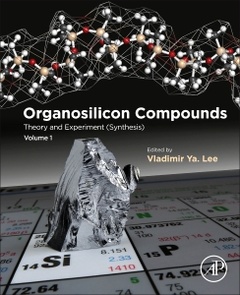Description
Organosilicon Compounds
Theory and Experiment (Synthesis)
Coordinator: Lee Vladimir Ya
Language: English
Subjects for Organosilicon Compounds:
Keywords
Anion-radicals; Aromaticity; Asymmetric catalysis; Biradicals; Cage compound; Catalysis; Catalytic reactions; Chiral organosilicon compound; Chirality; Complexation; Dative bond; EPR spectroscopy; Electron counting rule; Half-sandwich and sandwich structures; Hexacoordinated silicon; Hypercoordinate silicon; Hypercoordination; Hypervalency; Hypervalent silicon; Isolable; Lewis acid; Low-coordinate species; Molecular structure; NMR spectroscopy; Oligosilanes; Organosilicon chemistry; Organosilico
Support: Print on demand
Description
/li>Contents
/li>Readership
/li>Biography
/li>Comment
/li>
Organosilicon Compounds: Theory and Experiment (Synthesis), volume 1, comprises two parts. The first part, Theory, covers state-of-the-art computational treatments of unusual nonstandard organosilicon compounds that classical bonding theory fails to describe adequately. The second part, Experiment (Synthesis), describes recent synthetic advances in the preparation of a variety of organosilicon compounds with different coordination numbers of the central silicon: from tetracoordinate to low-coordinate to hypercoordinate derivatives.
Organosilicon Compounds: From Theory to Synthesis to Applications provides a comprehensive overview of this important area of organic and organometallic chemistry, dealing with compounds containing carbon?silicon bonds. This field, which includes compounds that are widely encountered in commercial products such as in the fabrication of sealants, adhesives, and coatings, has seen many milestone discoveries reported during the last two decades. Beginning with the theoretical aspects of organosilicon compounds? structure and bonding, the book then explores their synthetic aspects, including main group element organosilicon compounds, transition metal complexes, silicon cages and clusters, low-coordinate organosilicon derivatives (cations, radicals, anions, multiple bonds to silicon, silaaromatics), and more. Next, readers will find valuable sections that explore physical and chemical properties of organosilicon compounds by means of X-ray crystallography, 29Si NMR spectroscopy, photoelectron spectroscopy, and other methods. Finally, the work delves into applications for industrial uses and in many related fields, such as polymers, material science, nanotechnology, bioorganics, and medicinal silicon chemistry.
Chapter I.1 Nonclassical Organosilicon Compounds
II. Experiment
II.1. Synthesis
II.1.1. Organosilicon Compounds of Tetracoordinate Silicon
Chapter II.1.1.1. Transition Metal Complexes of Silicon (excluding silylene complexes)
Chapter II.1.1.2. Silicon Cages and Clusters
Chapter II.1.1.3. Chiral Organosilicon Compounds
II.1.2. Organosilicon Compounds of Low-Coordinate Silicon
Chapter II.1.2.1. Silicon-Centered Cations
Chapter II.1.2.2. Silicon-Centered Radicals
Chapter II.1.2.3. Silicon-Centered Anions
Chapter II.1.2.4. Silylenes and Their Transition Metal Complexes
Chapter II.1.2.5. Multiple Bonds to Silicon
Chapter II.1.2.6. Silaaromatics and Related Compounds
II.1.3. Organosilicon Compounds of Hypercoordinate Silicon
Chapter II.1.3.1. Penta - and Hexacoordinated Silicon (IV) Compounds
II.2. Physico-Chemical Studies
Chapter II.2.1. X-Ray Crystallography of Organosilicon Compounds
Chapter II.2.2. 29Si NMR Spectroscopy
Chapter II.2.3. Thermochemistry of Organosilicon Compounds
Chapter II.2.4. Photoelectron Spectroscopy of Organosilicon Compounds
III. Applications
Chapter III.1. Hydrosilylation of the Carbon–Carbon Multiple Bonds
Chapter III.2. Polysilanes
Chapter III.3. Siloxanes and Silicones
Chapter III.4. Silicon-Based Dendrimers and Irregular Hyperbranched Polymers
Organic, organometallic, Main group chemistry researchers
- Features valuable contributions from prominent experts that cover both fundamental (theoretical, synthetic, physico-chemical) and applied (material science, applications) aspects of modern organosilicon chemistry
- Covers important breakthroughs in the field, along with the historically significant achievements of the past
- Includes applied information for a wide range of specialists, from junior and senior researchers (from both academia and industry)
- Ideal reference for those working in organometallic, organosilicon, main group element, transition metal, and industrial silicon chemistry, as well as those from interdisciplinary fields, such as polymer, material science, and nanotechnology




